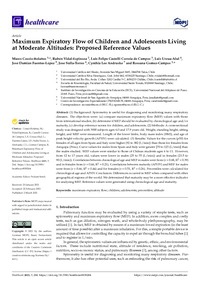Mostrar el registro sencillo de la publicación
Maximum expiratory flow of children and adolescents living at moderate altitudes: Proposed reference values
| dc.contributor.author | Cossio-Bolaños, Marco Antonio | |
| dc.contributor.author | Vidal-Espinoza, Rubén | |
| dc.contributor.author | Castelli Correia de Campos, F. | |
| dc.contributor.author | Urzúa Alul, Luis | |
| dc.contributor.author | Fuentes-López, José D. | |
| dc.contributor.author | Sulla-Torres, José | |
| dc.contributor.author | Lee-Andruske, Cynthia | |
| dc.contributor.author | Gómez-Campos, Rossana | |
| dc.date.accessioned | 2021-12-15T13:46:53Z | |
| dc.date.available | 2021-12-15T13:46:53Z | |
| dc.date.issued | 2021 | |
| dc.identifier.uri | http://repositorio.ucm.cl/handle/ucm/3621 | |
| dc.description.abstract | Background: Spirometry is useful for diagnosing and monitoring many respiratory diseases. The objectives were: (a) compare maximum expiratory flow (MEF) values with those from international studies, (b) determine if MEF should be evaluated by chronological age and/or maturity, (c) develop reference norms for children, and adolescents. (2) Methods: A cross-sectional study was designed with 3900 subjects ages 6.0 and 17.9 years old. Weight, standing height, sitting height, and MEF were measured. Length of the lower limbs, body mass index (BMI), and age of peak height velocity growth (APHV) were calculated. (3) Results: Values for the curves (p50) for females of all ages from Spain and Italy were higher (92 to 382 (L/min)) than those for females from Arequipa (Peru). Curve values for males from Spain and Italy were greater [70 to 125 (L/min)] than the males studied. MEF values were similar to those of Chilean students ages 6 to 11. However, from 12 to 17 years old, values were lower in males (25 to 55 (L/min)) and in females (23.5 to 90 (L/min)). Correlations between chronological age and MEF in males were from (r = 0.68, R2 = 0.39) and in females from (r = 0.46, R2 = 0.21). Correlations between maturity (APHV) and MEF for males were from (r = 0.66, R2 = 0.44) and for females (r = 0.51, R2 = 0.26). Percentiles were calculated for chronological age and APHV. Conclusion: Differences occurred in MEF when compared with other geographical regions of the world. We determined that maturity may be a more effective indicator for analyzing MEF. Reference values were generated using chronological age and maturity. | es_CL |
| dc.language.iso | en | es_CL |
| dc.rights | Atribución-NoComercial-SinDerivadas 3.0 Chile | * |
| dc.rights.uri | http://creativecommons.org/licenses/by-nc-nd/3.0/cl/ | * |
| dc.source | Healthcare, 9(3), 264 | es_CL |
| dc.subject | Maximum expiratory flow | es_CL |
| dc.subject | Children | es_CL |
| dc.subject | Adolescents | es_CL |
| dc.subject | Percentiles | es_CL |
| dc.subject | Altitude | es_CL |
| dc.title | Maximum expiratory flow of children and adolescents living at moderate altitudes: Proposed reference values | es_CL |
| dc.type | Article | es_CL |
| dc.ucm.facultad | Facultad de Ciencias de la Educación | es_CL |
| dc.ucm.indexacion | Scopus | es_CL |
| dc.ucm.indexacion | Isi | es_CL |
| dc.ucm.uri | www.mdpi.com/2227-9032/9/3/264 | es_CL |
| dc.ucm.doi | doi.org/10.3390/healthcare9030264 | es_CL |



